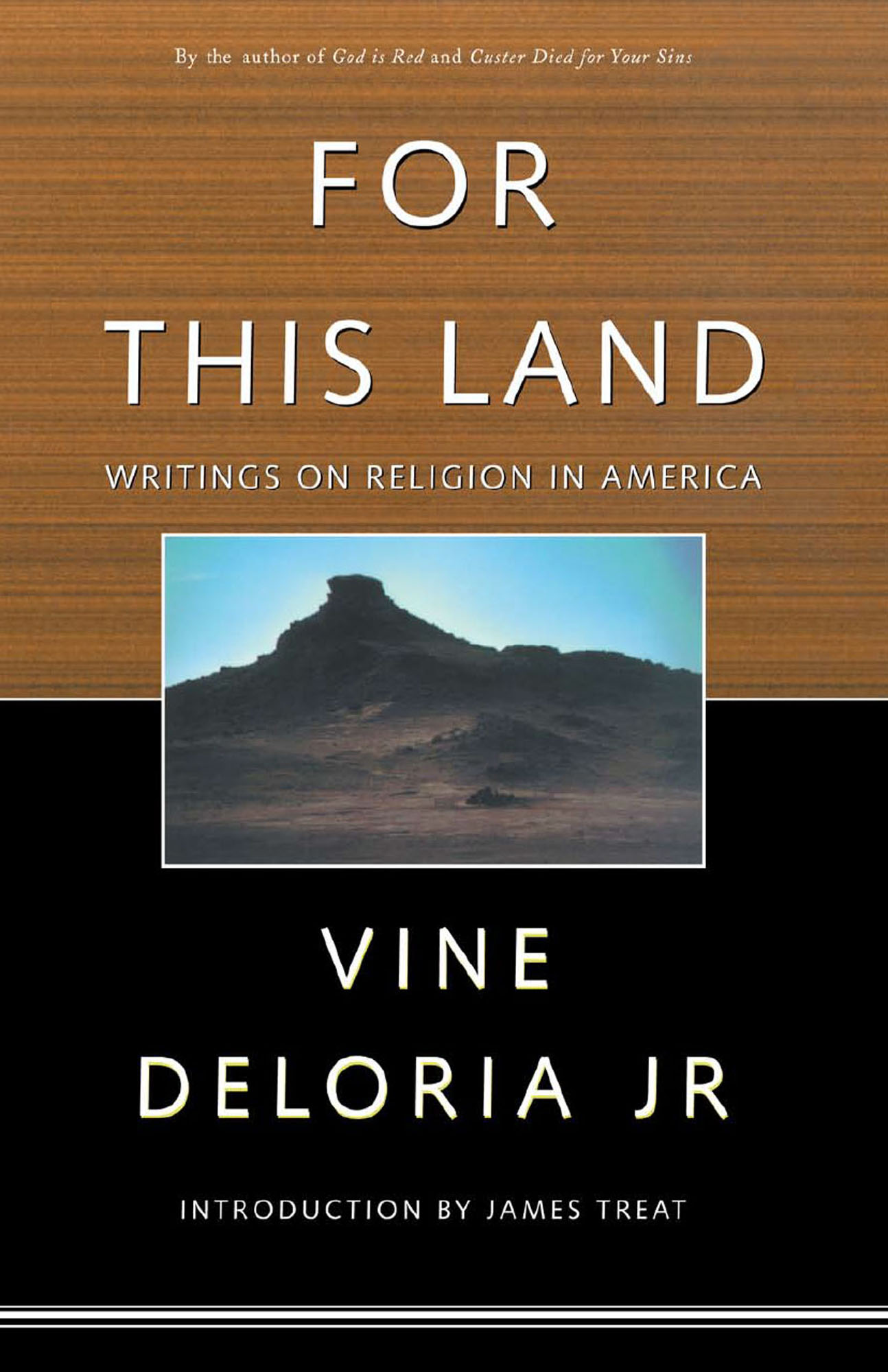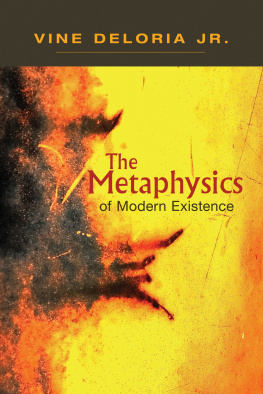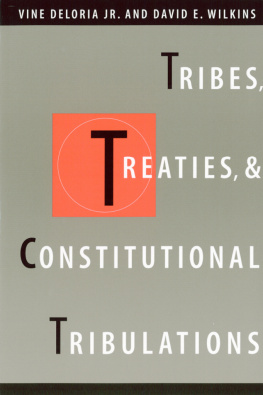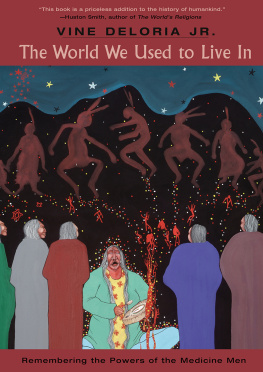
For this Land
For this Land Writings on Religion in America
Vine Deloria, Jr.
Edited and with an Introduction by James Treat

Published in 1999 by
Routledge
605 Third Avenue,
New York, NY 10017
Published in Great Britain by
Routledge
2 Park Square, Milton Park,
Abingdon, Oxon, OX14 4RN
Transferred to Digital Printing 2011
Copyright 1999 by Vine Deloria, Jr. Introduction, Headnotes, and Bibliography copyright
1999 by James Treat.
Cover photograph: Within the famous racetrack that encompasses the Black Hills of South Dakota, in a small prairie clearing, is a sacred place where generations of people have come to seek counsel with higher powers. Not all sacred places are large and overpowering, like Bear Butte or Bear Lodge, since silence is valued above all things when ceremonies are performed.
Cover photography by Vine Deloria, Jr.
All rights reserved. No part of this book may be reprinted or reproduced or utilized in any form or by any electronic, mechanical, or other means, now known or hereafter invented, including photocopying and recording or in any information storage or retrieval system, without permission in writing from the publishers.
Library of Congress Cataloging-in-Publication Data
Deloria, Vine.
For this land : writings on religion in America / Vine Deloria, Jr.: edited by James Treat.
p. cm.
Includes bibliographical references and index.
ISBN 0-415-92114-7 (hardcover : alk. paper). ISBN 0-415-92115-5 (pbk. : alk. paper)
DOI: 10.4324/9780203949573
1. Indians of North AmericaReligion. 2. United StatesReligion. 3. Freedom of religionUnited States, I. Treat, James. II. Title.
E98.R3D43 1998
199.7dc21
98-15500
CIP
Publishers Note
The publisher has gone to great lengths to ensure the quality of this reprint but points out that some imperfections in the original may be apparent.
While America has produced great businessmen and scientists, it has been unable to produce one great philosopher or theologian.
The Red Man in the New World Drama
Religion cannot be kept within the bounds of sermons and scriptures. It is a force in and of itself and it calls for the integration of lands and peoples in harmonious unity. The lands wait for those who can discern their rhythms. The peculiar genius of each continent, each river valley, the rugged mountains, the placid lakesall call for relief from the constant burden of exploitation.
Who will find peace with the lands? The future of humankind lies waiting for those who will come to understand their lives and take up their responsibilities to all living things. Who will listen to the trees, the animals and birds, the voices of the places of the land? As the long-forgotten peoples of the respective continents rise and begin to reclaim their ancient heritage, they will discover the meaning of the lands of their ancestors. That is when the invaders of the North American continent will discover that for this land, God is red.
God Is Red
Introduction An American Critique of Religion
DOI: 10.4324/9780203949573-1
On September 9, 1974, the weekly news magazine Time reported that a survey of religious leaders and scholars had produced a list of eleven shapers and shakers of the Christian faith, including Vine Deloria, Jr.
Shapers and Shakers,
Time 104 (September 9,1974): 66. Others named to the list were Brazilian Archbishop Helder Cmara, Jesuit philosopher Bernard Lonergan, sociologist Andrew Greeley, feminist theologian Rosemary Radford Ruether, Christian ethicist James Gustafson, Rhodesian Methodist Bishop Abel Muzorewa, and Pentecostal leader David du Plessis. Deloria, Vine (Victor), Jr.,
Contemporary Authors, vols. 5356, edited by Clare D. Kinsman (Detroit, MI: Gale Research Company, 1975), 146.
Why would influential representatives of North Americas Christian establishment choose such an iconoclastand an apostate one at that for their roster of religious luminaries? Writing in The Christian Century, one of the periodicals that sponsored the Interchurch Features survey, columnist Martin Marty suggested that some degree of liberal tokenism was involved in the process; the list also included one Latin American, one African, and one woman, three demographic strongholds of modern Christianity that are still underrepresented in ecclesiastical leadership and theological scholarship.
Martin E. Marty, M.E.M.O.: Billy Et Al,
Christian Century 91 (September 4, 1974): 831. James A. Taylor, Giants of Our Faith,
U.S. Catholic 39, no. 12 (December 1974): 22.
If Delorias selection as a Theological Superstar of the Future seemed an appropriate recognition at the time, it was not a particularly good predictor of his subsequent impact as a shaper and shaker of the Christian faith. All of his fellow luminaries went on to distinguish themselves as religious leaders and scholars and today are among the most influential figures in their particular corners of the Christian world. Yet Deloria has never been listed in Whos Who in Religion (through four editions, 197592) or among the 550 individuals included in the Dictionary of American Religious Biography. The Encyclopedia of the American Religious Experience and The Encyclopedia of American Religious History also contain no reference to Deloria or his writings. How should we account for this turn of events? Was Deloria a theological superstar or only a meteor, a charismatic streak of light in the religious firmament?
Whos Who in Religion, 4th ed., 199293 (Wilmette, IL: Marquis Whos Who, 1992); Henry Warner Bowden,
Dictionary of American Religious Biography, 2nd. ed. (Westport, CT: Greenwood Press, 1993); Charles H. Lippy and Peter W. Williams, eds.,
Encyclopedia of the American Religious Experience: Studies of Traditions and Movements, 3 vols. (New York, NY: Charles Scribners Sons, 1988); Edward L. Queen II, Stephen R. Prothero, and Gardiner H. Shattuck, Jr., eds.,
The Encyclopedia of American Religious History, 2 vols. (New York, NY: Facts on File, 1996). Joseph Epes Brown, Black Elk, in
The Encyclopedia of Religion, vol. 2, edited by Mircea Eliade (New York, NY: Macmillan Publishing Company, 1987), 234; ke Hultkrantz, North American Religions: Mythic Themes, in
The Encyclopedia of Religion, vol. 10, 535. For example, see: Roger Dunsmore, Vine Deloria, Jr., in
Dictionary of Native American Literature, edited by Andrew Wiget (New York, NY: Garland Publishing, 1994), 41115; Vine Deloria, Jr., in
The Native North American Almanac, edited by Duane Champagne (Detroit, MI: Gale Research, 1994), 104344; Clifford M. Lytle, Jr., Vine Deloria, Jr., in
Leaders from the 1960s: A Biographical Sourcebook of American Activism, edited by David DeLeon (Westport, CT: Greenwood Press, 1994), 7278; Karen P. Zimmerman, Vine Deloria, Jr., in
Notable Native Americans, edited by Sharon Malinowski (New York, NY: Gale Research, 1995), 11821.
Deloria did appear in Whos Who in America (Chicago, IL: Marquis Whos Who) for two decades beginning with the 1972 edition, but was dropped for the 1992 edition, perhaps to commemorate the five-hundredth anniversary of the beginning of the church-sanctioned colonization of his homeland.
Like several of his fellow luminaries, Delorias intellectual energies have been divided between religious affairs and other pressing concerns for much of his professional career. His continuing involvement in the persistent political struggles facing American Indians has precluded the kinds of theological contributions made by prolific European scholars such as Kng and Moltmann. And unlike all of the other ten superstars, Deloria has dissented from the Western religious mainstream by maintaining a non-Christian stance, not relying on any Christian institutions for bureaucratic legitimation. His writings have elicited very little critical response from scholars of religion, perhaps because his ideas are simply too far outside the bounds of prevailing academic sentiment, which is still burdened by an unfortunate intellectual parochialism. Only a few scholars of religion have responded in print to the criticisms and proposals contained in
Next page






